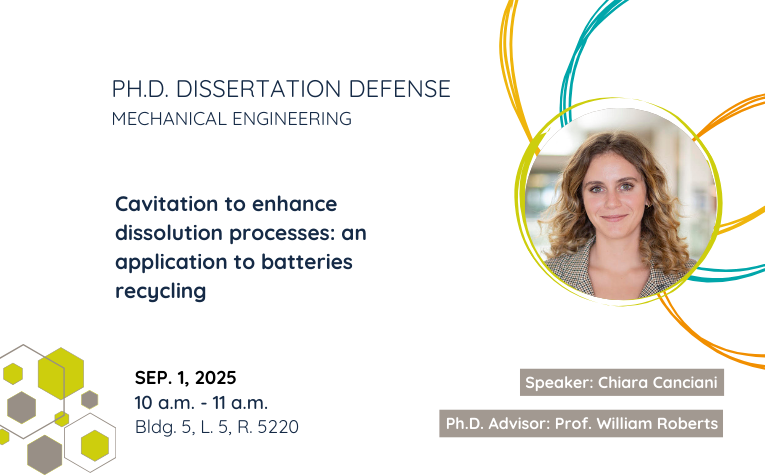Sep 2025
Cavitation to enhance dissolution processes: an application to batteries recycling

Zoom link: https://kaust.zoom.us/j/96075267363
Abstract
A rampant electrification has characterized the past ten years, sustained by the policies and investments towards the transition to renewable energies. To maintain this trend and fulfill the future energy demand, the production of batteries needs to increase further, straining the critical minerals resources. To maintain a steady supply of battery metals and reduce the dependence on ore mining, the recovery of critical minerals from production scrap and spent batteries recycling must be a non-negotiable. However, current recycling technologies require large capital investment for the construction of high-capacity process plants to exploit the economy of scale, limiting the feasibility of the solutions. Process intensification can potentially lower the costs related to the recycling process, leading to more economic solutions and lower environmental impact. In this framework, this work focuses on the dissolution of cathode material (leaching) in an acid solution, the core step in hydrometallurgical recycling. Cavitation is a tool to improve transport properties in the liquid, due to the collapse of bubbles after changes in the local pressure. The optimal conditions of the intensified process are searched, exploring different methods to generate cavitation: ultrasonic and hydrodynamic. NMC111 is used as model material, due to the widespread utilization of this layered oxide as a cathode material, and the elevated content of nickel and cobalt which makes it a excellent candidate for recycling. The addition of the reducing agent is investigated, to assess its effect on the leaching mechanism of NMC111, and its concomitant action with ultrasound. Then, the work focuses on the effect of ultrasound application, to quantify the changes in solid properties brought by the enhanced process with respect to the conventional one. These works combined reconstruct the physical phenomena occurring in the cavitation-enhanced leaching process, and explains their integration with the leaching chemistry. Finally, this work uses acoustic measurements to monitor the cavitation activity in the ultrasonic leaching process and correlate the changes in size and morphology of the particles to those in the cavitation intensity, exploring a peculiarity occurring in the leaching process of NMC111 that can be used to better control the advancement of the process. This work will be valuable to researchers, environmental scientists and policy makers in the recycling industry to choose appropriate processes.
Biography
Chiara Canciani is a PhD candidate in Mechanical Engineering at KAUST’s Clean Energy Research Platform. She works on cavitation-driven processes to enhance metal recovery from battery recycling, collaborating with both academic and industrial partners. She earned her Bachelor’s and Master’s degrees in Chemical Engineering from Politecnico di Milano, graduating with honors.